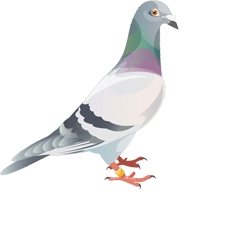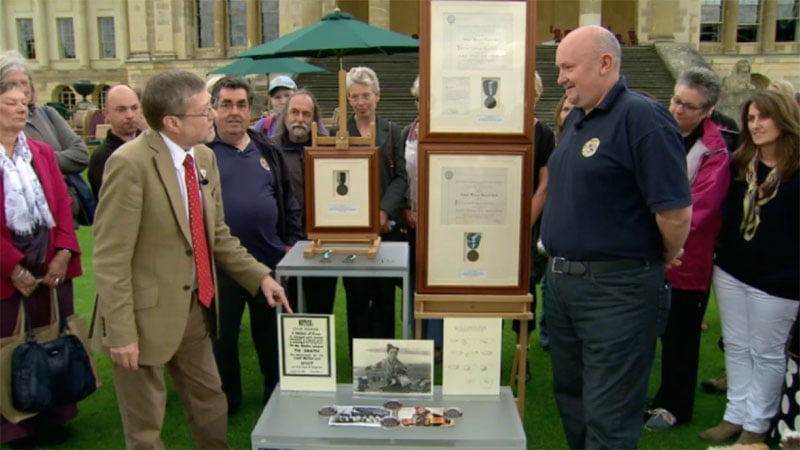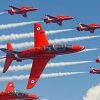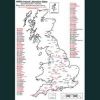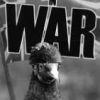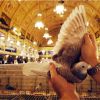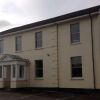 At the outbreak of World War 2 thousands of Britain’s pigeon fanciers gave their pigeons to the war effort to act as message carriers. During the period of the war nearly a quarter of a million birds were used by the Army, the RAF and the Civil Defence Services including the Police, the Fire Service, Home Guard and even Bletchley Park. Pigeon racing was suspended and birds of prey along the coasts of Britain were culled so that British pigeons could arrive home unhindered by these predators. There were tight controls on the keeping of pigeons and even rationing for pigeon corn.
At the outbreak of World War 2 thousands of Britain’s pigeon fanciers gave their pigeons to the war effort to act as message carriers. During the period of the war nearly a quarter of a million birds were used by the Army, the RAF and the Civil Defence Services including the Police, the Fire Service, Home Guard and even Bletchley Park. Pigeon racing was suspended and birds of prey along the coasts of Britain were culled so that British pigeons could arrive home unhindered by these predators. There were tight controls on the keeping of pigeons and even rationing for pigeon corn.
Homing pigeons were used not only in Western Europe by British forces but also by American, Canadian, and German forces in other parts of the world during the war – Italy, Greece, North Africa, India and the Middle and Far East. One pigeon, GI Joe, saved the lives of thousands of British troops who were preparing to take an Italian town after the US Air Force had bombarded the Germans. British forces found no resistance from the Germans and so entered the town unchallenged. Unfortunately the USAF were already en route to bomb the town and with radio contact broken GI Joe flew over a mile a minute (60 mph) back to his base. He arrived back just in time for the air raid to be called off before the USAF would have bombed our troops.
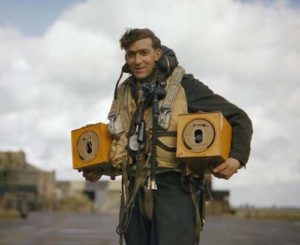 All RAF bombers and reconnaissance aircraft carried pigeons in special watertight baskets and containers and, if the aircraft had to ditch, the plane’s co-ordinates were sent back with the pigeon to its RAF base and a search and rescue operation was effected. Thousands of servicemen’s lives were saved by these heroic birds that flew often in extreme circumstances.
All RAF bombers and reconnaissance aircraft carried pigeons in special watertight baskets and containers and, if the aircraft had to ditch, the plane’s co-ordinates were sent back with the pigeon to its RAF base and a search and rescue operation was effected. Thousands of servicemen’s lives were saved by these heroic birds that flew often in extreme circumstances.
During World War II homing pigeons were seconded into the National Pigeon Service from Britain’s fanciers, including from the Royal Lofts. In fact one pigeon from the Royal Lofts – Royal Blue – was the first pigeon to bring a message from a force-landed aircraft on the continent. On the 10th October 1940 this young bird was released in Holland. He flew 120 miles in 4 hours 10 minutes reporting the information regarding the situation of the crew. For this action Royal Blue later received the Dickin Medal (see below).
 Pigeons carried their messages either in special message containers on their legs or small pouches looped over their backs.
Pigeons carried their messages either in special message containers on their legs or small pouches looped over their backs.
Quite often pigeons were dropped by parachute in containers to Resistance workers in France, Belgium and Holland. This was often very precarious as it was a bumpy landing, and it was very dangerous for the Resistance workers if they were caught with a British pigeon.
Pigeon lofts were built at RAF and Army bases, and mobile lofts were also constructed so that they could move easily over land.
FURTHER RESOURCES
A great film – ‘War of the Birds’ by Atlantic Productions for Animal Planet (2005) – detailing the contribution made by pigeons to the war effort, can be seen here.
A comprehensive history of the National Pigeon Service is detailed here.
Jennifer Spangler’s excellent blog on military intelligence and pigeons in war features scans of many relevant documents – most highly secret at the time – which tell the story of the contribution that carrier pigeons made to the war effort, the risks run by local inhabitants and agents to send back information, and the attempts made by the German forces to thwart the operations.
THE PDSA DICKIN MEDAL
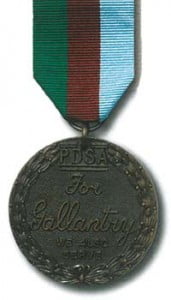 The PDSA Dickin Medal is awarded to any animal displaying conspicuous gallantry and devotion to duty. Of the 53 Dickin Medals presented during World War II, 32 went to pigeons.
The PDSA Dickin Medal is awarded to any animal displaying conspicuous gallantry and devotion to duty. Of the 53 Dickin Medals presented during World War II, 32 went to pigeons.
The founder of the PDSA – People’s Dispensary for Sick Animals – Mrs Maria Dickin, instituted the award, popularly referred to as the ‘Animal VC’, which is made only upon official recommendation and is exclusive to the animal kingdom.
One of the most famous pigeons was called ‘White Vision’. It received its Dickin Medal for “delivering a message under exceptionally difficult conditions and so contributing to the rescue of an aircrew while serving with the RAF in October 1943”. This hardly tells the story! A Catalina flying boat had to ditch in the Hebrides at 0820 hrs one morning. Sea rescue operations were hindered by very bad weather and air search was impossible because of thick mist. At 1700 hrs that afternoon White Vision arrived at her loft with a message giving the position of the ditched aircraft and as a result the search was resumed, the aircraft sighted and rescue of the crew effected. White Vision had flown 60 miles over heavy seas against a headwind of 25 miles per hour with visibility only a hundred yards at the place of release and three hundred yards at the place of arrival.
There are British Pathé News clips on youtube of Dickin Medals being presented to Gustav and Paddy and to GI Joe, and here is a slideshow tribute to the 32 Flying Heroes.
PDSA DICKIN MEDAL PIGEON RECIPIENTS
| DM1: Winkie Pigeon NEHU.40.NS.1 Bred by A R Colley, Whitburn Date of Award: 2 December 1943 “For delivering a message under exceptionally difficult conditions and so contributing to the rescue of an aircrew while serving with the RAF in February 1942.” |
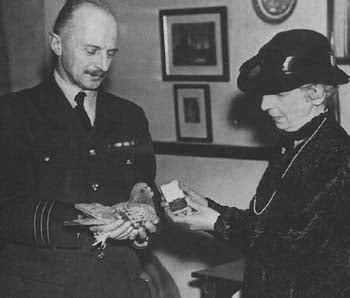 |
| DM2: Tyke (also known as George) Pigeon MEPS.43.1263 Bred by Middle East Pigeon Service Date of Award: 2 December 1943 “For delivering a message under exceptionally difficult conditions and so contributing to the rescue of an aircrew, while serving with the RAF in the Mediterranean in June 1943.” |
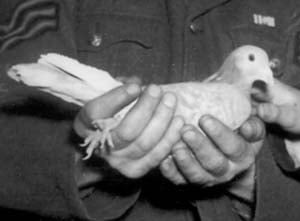 |
| DM3: White Vision Pigeon SURP.41.L.3089 Bred by Fleming Bros, Motherwell Date of Award: 2 December 1943 “For delivering a message under exceptionally difficult conditions and so contributing to the rescue of an aircrew while serving with the RAF in October 1943.” |
 |
| DM4: Beachcomber Pigeon NPS.41.NS.4230 Bred by W Lane, Ipswich Date of Award: 6 March 1944 “For bringing the first news to this country of the landing at Dieppe, under hazardous conditions in September 1942, while serving with the Canadian Army.” |
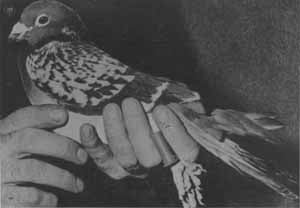 |
| DM6: Gustav Pigeon NPS.42.31066 Bred by F E Jackson, Cosham Date of Award: 1 September 1944 “For delivering the first message from the Normandy Beaches from a ship off the beach-head while serving with the RAF on 6 June 1944.” |
 |
| DM7: Paddy Pigeon NPS.43.9451 Bred by A S Hughes, Northern Ireland Date of Award: 1 September 1944 “For the best recorded time with a message from the Normandy Operations, while serving with the RAF in June 1944.” |
 |
| DM13: Kenley Lass Pigeon NURP.36.JH.190 Bred by W H Torkington, Poynton Date of Award: March 1945 “For being the first pigeon to be used with success for secret communications from an agent in enemy-occupied France while serving with the NPS in October 1940.” |
 |
| DM14: Commando Pigeon NURP.38.EGU.242 Bred by S Moon, Haywards Heath Date of Award: March 1945 “For successfully delivering messages from agents in Occupied France on three occasions: twice under exceptionally adverse conditions, while serving with the NPS in 1942.” |
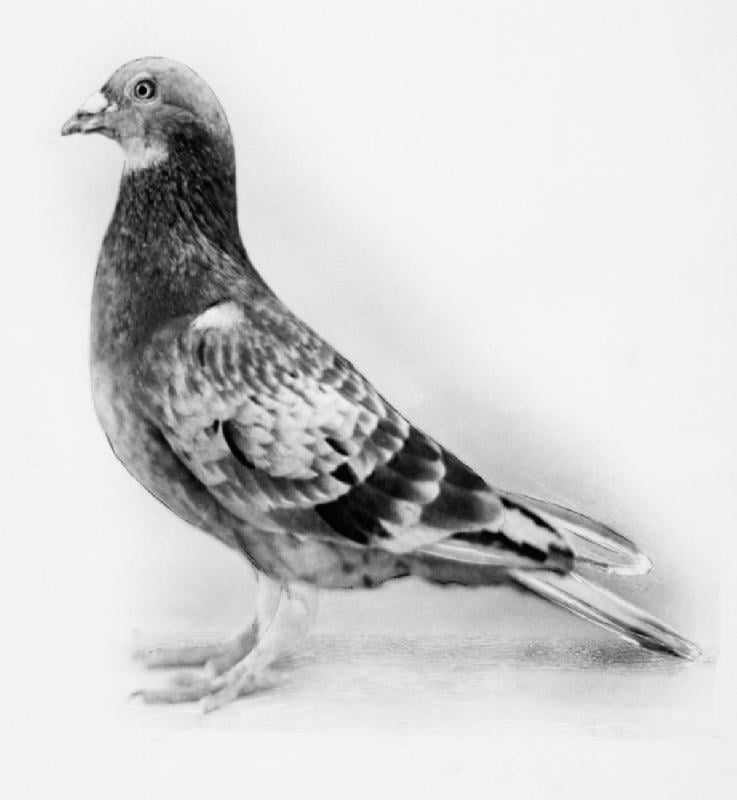 |
| DM15: Flying Dutchman* Pigeon – NPS.42.NS.44802 Bred by E G Forster, Walthamstow Date of Award: March 1945 “For successfully delivering messages from agents in Holland on three occasions. Missing on fourth mission, while serving with the RAF in 1944.” |
 |
| DM16: Royal Blue Pigeon NURP.40.GVIS.453 Bred by The Royal Lofts, Sandringham Date of award: March 1945 “For being the first pigeon in this war to deliver a message from a forced landed aircraft on the continent while serving with the RAF in October 1940.” Royal Blue was owned by King George VI. |
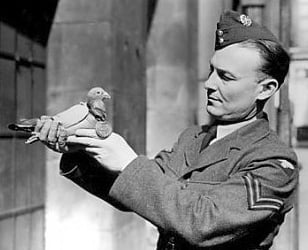 |
| DM17: Dutch Coast Pigeon NURP.41. A.2164 Bred by J Flower, Radcliffe-on-Trent Date of Award: March 1945 “For delivering an SOS from a ditched aircrew close to the enemy coast, covering 288 miles distance in 7½ hours, under unfavourable conditions, while serving with the RAF in April 1942.” |
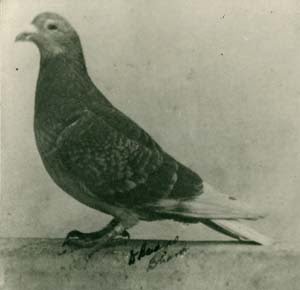 |
| DM18: Navy Blue Pigeon NPS.41.NS.2862 Bred by Royal Air Force Date of Award: March 1945 “For delivering an important message from a raiding party on the west coast of France, although injured, while serving with the RAF in June, 1944. |
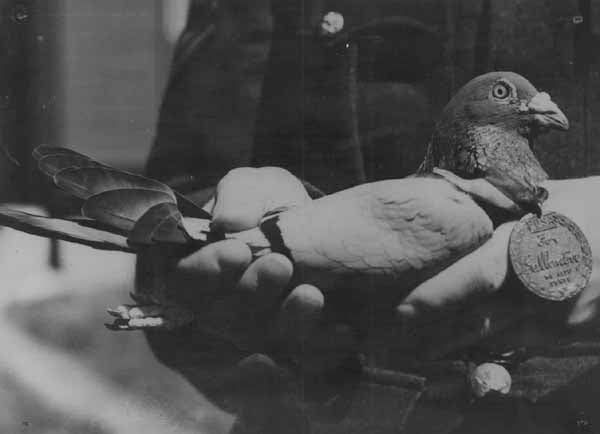 |
| DM21: William of Orange Pigeon NPS.42.NS.15125 Bred by W Proctor Smith, Knutsford Date of Award: May 1945 “For delivering a message from the Arnhem Airborne Operation in record time for any single pigeon, while serving with the APS in September 1944.” |
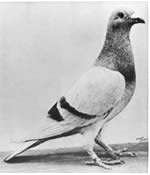 |
| DM22: Ruhr Express Pigeon NPS.43.29018 Bred by Royal Air Force Date of Award: May 1945 “For carrying an important message from the Ruhr Pocket in excellent time, while serving with the RAF in April, 1945.” |
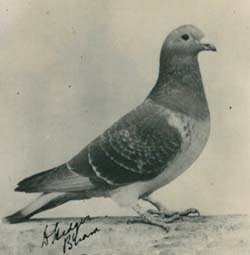 |
| DM23: Scotch Lass Pigeon NPS.42.21610 Bred by Collins & Son, Musselburgh Date of Award: June 1945 “For bringing 38 microphotographs across the North Sea in good time although injured, while serving with the RAF in Holland in September 1944.” |
 |
| DM25: Billy Pigeon NU.41.HQ.4373 Bred by J Greenwood, Lincoln Date of Award: August 1945 “For delivering a message from a force-landed bomber, while in a state of complete collapse and under exceptionally bad weather conditions, while serving with the RAF in 1942.” |
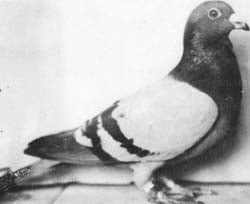 |
| DM26: Cologne Pigeon NURP.39.NPS.144 Bred by W H Payne, Nottingham Date of Award: unknown “For homing from a crashed aircraft over Cologne although seriously wounded, while serving with the RAF in 1943.” |
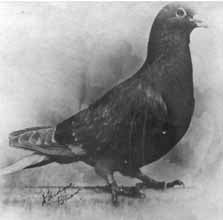 |
| DM28: Maquis Pigeon NPS.42.NS.36392 Bred by Brown Bros, Bedford Date of Award: October 1945 “For bringing important messages three times from enemy occupied country, viz: May 1943 (Amiens), February 1944 (Combined Operations) and June 1944 (French Maquis) while serving with the Special Service from the Continent.” |
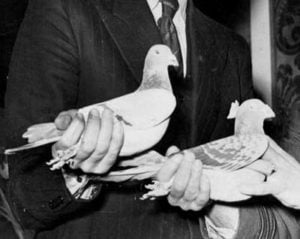 |
| DM29: Pigeon NPS.42.NS.2780* Bred by B Powell, Hereford Date of Award: October 1945 “For bringing important messages three times from enemy occupied country, viz: July 1942, August 1942 and April 1943, while serving with the Special Service from the Continent.” |
 |
| DM30: Pigeon NPS.42.NS.7524 Bred by C Dyson, Barnsley Date of Award: October 1945 “For bringing important messages three times from enemy-occupied country, viz: July 1942, May 1943 and July 1943, while serving with the Special Service from the continent.” |
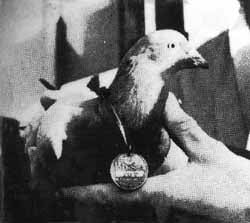 |
| DM31: Broad Arrow Pigeon NPS.41.BA.2793 Bred by Army Pigeon Service Date of Award: October 1945 “For bringing important messages three times from enemy occupied country, viz: May 1943, June 1943 and August 1943, while serving with the Special Service from the Continent.” |
 |
| DM32: Mary Pigeon NURP.40.WCE.249 Bred by C Brewer, Exeter Date of Award: November 1945 “For outstanding endurance on War Service in spite of wounds.” Mary survived an attack by a German-kept hawk in France, returning with wounds to her neck and breast, and on another occasion returned with a wing tip shot off. In her final trip she sustained neck muscle damage due to shrapnel; her owner made her a leather collar to hold her head up and immediately retired her. Mary had also survived her loft being wrecked by a bomb during the raids on Exeter in 1942, which had killed many of her fellow pigeons. |
 |
| DM34: Tommy Pigeon NURP.41.DHZ.56 Bred by W Brockbank, Barrow-in-Furness Date of Award: February 1946 “For delivering a valuable message from Holland to Lancashire under difficult conditions, while serving with NPS in July 1942.” |
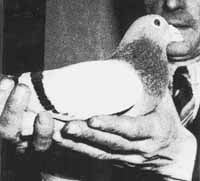 |
| DM35: All Alone Pigeon NURP.39.SDS.39 Bred by J W Paulger, Twickenham Date of Award: February 1946 “For delivering an important message in one day over a distance of 400 miles, while serving with the NPS in August 1943.” |
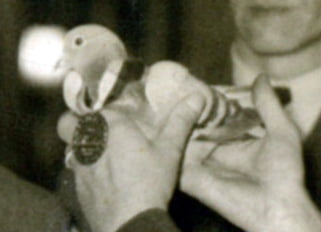 |
| DM36: Princess* Pigeon NPS.42.WD.593 Bred by Middle East Pigeon Service Date of Award: May 1946 “For carrying valuable information 500 miles from Crete to Alexandria in April 1943. One of the finest performances in pigeon war service records.” |
 |
| DM38: Mercury Pigeon NURP.37.CEN.335 Bred by J Catchpole, Ipswich Date of Award: August 1946 “For carrying out a special task involving a flight of 480 miles from Northern Denmark while serving with the Special Section, Army Pigeon Service, in July 1942.” |
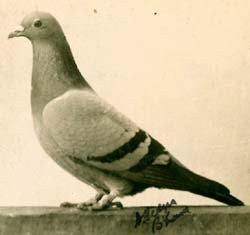 |
| DM39: Pigeon NURP.38.BPC.6* Bred by S J Bryant, Bridgewater Date of Award: August 1946 “For three outstanding flights from France while serving with the Special Section, Army Pigeon Service, 11 July 1941, 9 September 1941, and 29 November 1941.” |
 |
| DM40: GI Joe Pigeon USA.43.SC.6390 Bred by US Army Date of Award: August 1946 “For prompt delivery of a message to XII Air Support Command, thereby preventing the bombing of advanced elements 56th (London) Division, while serving with the US Signal Corps at Colvi Vecchia, Italy, 18 October 1943.” |
 |
| DM41: Pigeon DD.43.T.139 (Australian Army Signal Corps) Bred by Australian Pigeon Service Date of award: February 1947 “For carrying an SOS message from an Army boat stranded in Huron Gulf in a tropical storm in June 1945, which resulted in the saving of the craft, crew and valuable cargo.” |
 |
| DM42: Pigeon DD.43.Q.879 (Australian Army Signal Corps) Bred by Australian Pigeon Service Date of award: February 1947 “For carrying an SOS message under heavy fire which brought relief to a patrol of US Marines cut off by Japanese on Manus Island.” |
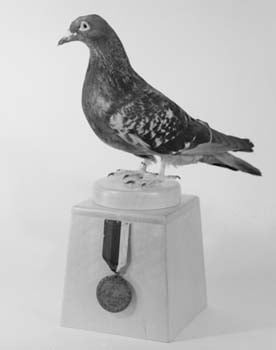 |
| DM45: Duke of Normandy Pigeon NURP.41.SBC.219 Bred by G Noterman, Shepherds Bush Date of Award: 8 January 1947 “For being the first pigeon to home from paratroops behind the German lines on D Day in adverse weather after five days’ detention in a small container.” |
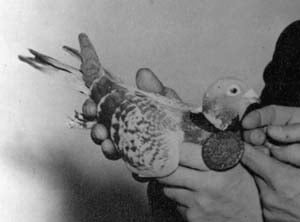 |
| DM46: Pigeon NURP.43.CC.1418* Bred by T Markham, Kendal Date of Award: 8 January 1947 “For being the only pigeon to home from British Airborne Units and Paratroops in Normandy operations in less than 24 hours in adverse weather after five days’ detention in a small container.” |
 |
| *Indicates the medal was awarded posthumously |
Following Victory in Europe, the Secretary of State for War issued this letter to fanciers that had contributed to the war effort.
In 2013 then RPRA General Manager, Stewart Wardrop, took the Association’s collection of memorabilia along to the Antiques Roadshow at Stowe House. Click on the image below to see the BBC website’s article on the valuation, where there is also a link to watch a video clip from the programme.
